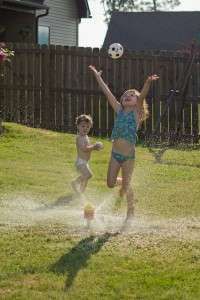Three-year, 676-child trial shows effectiveness of low-cost intervention to improve sun protection

A blistering sunburn during childhood or adolescence more than doubles the adult risk of skin cancer. The accumulation of long-term sun exposure may be equally dangerous. A study from the Colorado School of Public Health and the University of Colorado Cancer Center recently published in the American Journal of Preventive Medicine shows one way to reduce this exposure: a double-blind randomized clinical trial of mailed sun protection packets led to higher frequency of sun protective behaviors including the use of long clothing, hats, shade, sunscreen, and midday sun avoidance.
"This is a low-cost, effective intervention that could be an important component in efforts to reduce sun exposure in children during the years that they acquire much of their risk for skin cancer," says the paper's first author, Lori Crane, PhD, MPH, CU Cancer Center investigator and chair of the Department of Community & Behavioral Health at the Colorado School of Public Health.
The study recruited 676 six-year-olds and their parents into the Colorado Kids Sun Care Program, half of whom completed phone interviews and other data collection, and half of whom also received intervention kits. Kits included newsletters and sun protection resources, such as swim shirts, hats, sunscreen and sun protection educational activities. They were mailed in April and May of the years 2005, 2006 and 2007, with the goal of guiding parents and children to ever-increasing stages of adopting sun-safe behaviors, from the early stage of "unaware" to fully engaged and actively practicing. Phone interviews determined not only the level of sun-protective behaviors, but also parents' knowledge about melanoma, their evaluation of their child's lifetime risk for the disease, and their opinion of skin cancer severity. Skin exams discovered children's level of tanning and number of nevi – the UV-influenced moles that can presage melanoma.
Across all measures of sun-protective behavior and awareness, the intervention group showed greater gains than the control group. Interestingly, the greatest increases were in the specific sun-protective behaviors emphasized in each yearly kit.
"After we emphasized long clothing in the spring of 2005, we saw a difference in clothing behavior in the summers of 2005 and 2006 not in 2007. Then after emphasizing hats in 2006, we saw a difference in hat use that year. And then after highlighting shade in 2007, we saw a corresponding increase in parents' awareness and use of shade as a sun-protective behavior," Crane says.
In Crane's opinion, this specific awareness and behavior change shows both the effectiveness of the intervention, but perhaps also the challenge of creating lasting behavior changes. Further study is needed to discover the durability of this intervention, and also how these increases in sun-protective behaviors influence skin cancer risk.
Crane and colleagues point out that although behavior changes in the trial were modest, the intervention was relatively inexpensive and, because it used postal mail, it could be readily delivered to a geographically broad population.















